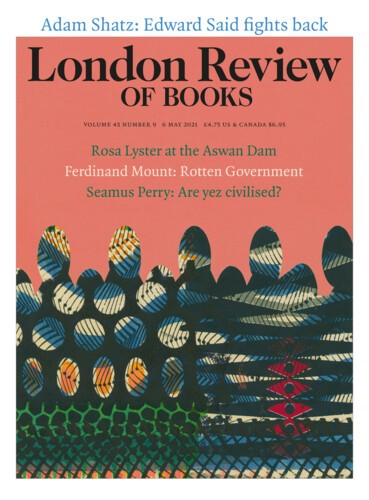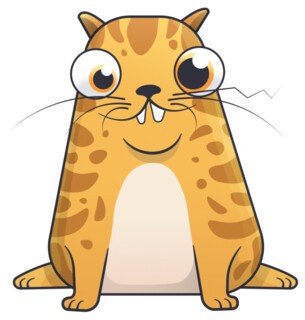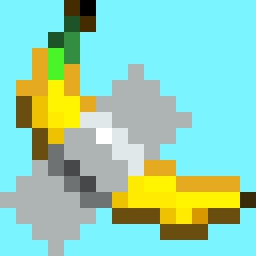Buzz Lightyear is naked, save for his standard-issue purple balaclava and a banana taped to his hairy stomach. He stands in front of the white wall of an art gallery; a label to his left reads ‘The Impossible Dream of a Pubic Fruit’ and an audience looks up at his giant grey legs. The image is one of five thousand that make up the digital artist Beeple’s collage Everydays: The First 5000 Days, the first purely digital artwork to be auctioned at Christie’s, on 11 March this year. It sold for $69.3 million, making it the third most expensive work by a living artist, after Jeff Koons’s Rabbit and David Hockney’s Portrait of an Artist. The buyer, Vignesh Sundaresan, called it a ‘significant piece of art history’. Sundaresan doesn’t own the copyright to Everydays. All he bought was a non-fungible token (NFT): a collection of data stored using blockchain technology. There is nothing stopping you from downloading the image yourself, printing it off and sticking it above the fireplace. It will look exactly the same.
Each time an NFT is created – or ‘minted’ – or is transferred from one digital account to another, the data recording the event is stored as part of a ‘block’ on a chain. Each block contains information from the previous block in the chain; sneakily try to change a line of code and the chain collapses, so the erroneous entry is easily discovered. This makes a blockchain, in theory, incorruptible. As soon as a transaction is made, it is broadcast across a vast network of computers: it is ‘decentralised’, meaning that anyone can be the detective who spots the crime. There is no single authority declaring what’s what. For almost as long as this technology has existed, people have been excited about its potential use as a means of securing the provenance of assets. If records of financial transfers can be made totally tamper-proof, then why not deeds to houses, or medical records, or entire digital artworks?
The artist Kevin McCoy and the technologist Anil Dash minted the first NFT in 2014 as a way for digital artists to keep control of their work. ‘McCoy used a blockchain called Namecoin to register a video clip that his wife had made,’ Dash explained in the Atlantic, ‘and I bought it with the four bucks in my wallet.’ Later that year a company called Counterparty set up a few NFT ‘marketplaces’ – websites where NFTs are bought and sold. The biggest was the Rare Pepe Directory, devoted to images of Pepe the Frog, the comic book character beloved of the alt-right. In 2017, Larva Labs released ten thousand pixellated cartoon characters – for free – on the Ethereum blockchain. They can now fetch millions of dollars apiece. After Beeple’s Everydays, the second most expensive NFT sold so far is CryptoPunk #3100, a bald alien with a headband, which fetched 4200 ether, or about $7.6 million (ether is a currency, just like bitcoin). One collector is planning to sell nine CryptoPunks at an upcoming auction in New York.
After CryptoPunks – inevitably, because this is the internet – someone came up with the idea of CryptoKitties, a game involving a digital marketplace where people could buy, sell and breed digital cats. An alarming number of CryptoKitties – fat little felines in a rainbow of colours – seem to have some form of anisocoria, where one pupil is larger than the other. Unlike the punks, which were all visually as well as cryptographically unique, two cats can look exactly the same, but since each kitten is attached to a unique NFT they’re treated as separate artworks, like prints in a series. Millions more dollars were made.
Because NFTs are essentially just digital deeds, they can be used to turn almost anything online into a saleable asset – pictures, video clips, even words on a webpage. In March the New York Times auctioned off an article about NFTs for 350 ether – half a million dollars. NBA Top Shot, the official NFT marketplace for the National Basketball Association, is a trading site for classic moments in basketball matches, like LeBron James dunking. William Shatner sold an X-ray of his teeth. I saw one developer offering NFTs of famous dates. Do you want to own Michael Jackson’s first moonwalk, on 25 March 1983? That’ll currently set you back 0.5 ether, or $1300. Bill Clinton’s impeachment on 19 December 1998? One ether. The first witch-burning at Salem on 10 June 1692? A steal at just 0.3 ether, or $780. One of the founders of Twitter, Jack Dorsey, auctioned an NFT of the first ever tweet, five words – ‘just setting up my twttr’ – that cost the winner some $2.9 million.
The owners of these digital artefacts have no rights to the intellectual property. Sina Estavi, who bought Dorsey’s tweet, can’t stop people retweeting it. Whoever bought the New York Times article can’t reprint it without permission. And of course no one can own a date: what people are actually buying are just JPEGs of a calendar with the purchased event marked in bold. So what’s the point? For richer investors, it’s an exercise in clout, a tech-bro muscle flex. Only a certain type of person wants to be able to lean over your shoulder as you watch the latest viral video or meme and shout: ‘That’s mine! I own it!’ For less wealthy traders, NFT ownership operates more like a collectible card game. The programmers who developed CryptoPunks were amazed by the number of people willing to take a ‘conceptual leap’ about what ownership can now mean. Estavi said that buying Dorsey’s first tweet was like owning the Mona Lisa.
One problem with NFTs – which Dash and McCoy first developed in a ‘one-night hackathon’ – is that the data storage capacity of a blockchain is limited. It’s really just a string of code, which is capable of representing anything, but it can’t be too long or it will be too expensive for the network to process. (It is possible to store images on the blockchain, but it costs way too much.) What Dash and McCoy came up with was a system that records a link to an image that exists somewhere on the web. ‘We took that shortcut because we were running out of time,’ Dash wrote. ‘Seven years later, all of today’s popular NFT platforms still use the same shortcut.’ Worse still, the link that is bought and sold leads to ‘the website of a new start-up that’s likely to fail within a few years’. Suddenly, NFTs seem no more indestructible than certificates of authenticity on plain old paper.
NFT artists and buyers are thrilled that they allow them to bypass the traditional gatekeepers of the industry and interact directly with their audience. The banana taped to the nude Buzz in Beeple’s Everydays has become something of a motif for digital artists – a big fuck you to gallerists and art-biz moguls. (Beeple’s picture is a reference to the satirical artist Maurizio Cattelan’s Comedian, an actual banana taped to a wall at Art Basel in 2019, which was the occasion for Twitter to explode with images of people sticking grapes, leeks and frozen peas to their kitchen cabinets.) The hope is that once venture capitalists and tech pioneers get bored of the novelty of NFTs, there will be some innovations worth holding on to. As one developer put it: ‘We will see some scammy projects, but there may be some gems with actual utility.’ A feature of NFTs that may make the gatekeepers superfluous is the option for artists to attach royalty clauses to their work. In this scenario, every time something is resold, the creator automatically takes a cut. If you buy an NFT of a song from a small band you like, the band gets an immediate investment as well as a royalty payment every time the token is sold on a secondary marketplace. If in a few years’ time they become global superstars, the NFT owner can make a lot of money – or, if they want to hold on to it, prove that they were there at the beginning.
Champions of NFTs should be alarmed by Christie’s smooth consumption of the concept, however. Maybe the buyers are different – so far, tech entrepreneurs and bitcoin fundamentalists rather than conventional collectors – but the business is the same: the perception of value can be exploited and translated into big bucks for the big beasts. The technology has already, and inevitably, been co-opted by corporations on the lookout for fresh markets. Nike has reportedly patented a ‘system and method for … mining, intermingling and exchanging blockchain-enabled digital shoes’. Taco Bell sold digital pictures of its products with a $500 gift card attached (only the first buyers were entitled to the free food). There will be a multitude of beneficial uses for blockchain technology, and the promise of true decentralisation is a boon, but the bleak fact is that NFTs are quickly becoming another tool for companies to sell us things we already own.
There’s another problem with NFTs: they have an exorbitant environmental impact. The computing power that underpins decentralisation consumes a huge amount of energy. Earlier this year, Cambridge researchers reported that bitcoin was using more energy than the whole of Argentina. In December 2020, the artist Memo Akten estimated that the average carbon footprint of a single NFT artwork was equivalent to driving a car more than six hundred miles. The sculptor Joanie Lemercier discovered that six NFTs he minted had used 8.7 megawatt-hours of energy, as much as he had expended in his studio in two years. Artists and marketplaces are trying to compensate for their environmental impact with somewhat glib gestures to carbon offsetting. When the musician Grimes sold a series of video art pieces on the Nifty Gateway marketplace, she donated an unspecified percentage of the $6 million proceeds to the climate-change NGO Carbon-180. (Access to Nifty Gateway, one of the biggest marketplaces for NFT artworks, is by invitation only. No gatekeepers, though, right?)
One of the most curious uses for NFTs so far has been in managing the exchange of digital building blocks in virtual gaming worlds. Decentraland is the latest in a long line of world-building videogames (Sim City, Civilisation, Theme Park World, Minecraft), and is underpinned by NFTs and cryptocurrency. Since its launch in 2017, tens of thousands of players have travelled, often using virtual reality headsets, through its digital world, using Decentraland’s own cryptocurrency (MANA) to buy and sell individual land parcels (LAND) on which citizens can build computer-generated real estate. Each piece of land is represented by an NFT. It’s still an embryonic universe, with many plots containing only a few benches and bushes, but the possibilities are bountiful – and lucrative. Decentraland has virtual book launches and virtual art galleries displaying digital artworks: one gallery houses miniature versions of paintings by Keith Haring and Jean-Michel Basquiat. Decentraland has bars, casinos, chapels, mosques. There’s even an electoral system in which users vote in referendums. It’s more like a plutocracy than a democracy: those with the most LAND and MANA get more votes. A couple of years ago a Decentraland user purchased 64 empty plots of land and combined them into a single estate. He called his new property ‘The Secret of Satoshi’s Tea Garden’ – a reference to Satoshi Nakamoto, the pseudonymous founder of bitcoin. But it also put me in mind of Borges’s ‘The Garden of Forking Paths’, in which the narrator, on learning of his great-grandfather’s theory of multiple dimensions, describes his surroundings in a way that could apply to the Decentraland universe: ‘I sensed the pullulation … that the dew-damp garden surrounding the house was infinitely saturated with invisible people … secretive, busy and multiform in other dimensions of time.’ Satoshi’s Tea Garden sold for $80,000, its price inflated because of its appealing location, completely surrounded by digital roads.
Send Letters To:
The Editor
London Review of Books,
28 Little Russell Street
London, WC1A 2HN
letters@lrb.co.uk
Please include name, address, and a telephone number.





